50s subunit antibiotics - Study guides, Class notes & Summaries
Looking for the best study guides, study notes and summaries about 50s subunit antibiotics? On this page you'll find 167 study documents about 50s subunit antibiotics.
Page 4 out of 167 results
Sort by

-
NURSING MSN 571 - Quiz 2 Study Guide.| VERIFIED GUIDE
- Exam (elaborations) • 75 pages • 2024
-
- $16.49
- + learn more
NURSING MSN 571 - Quiz 2 Study Guide.| VERIFIED GUIDE Antibiotics Review terminology: 1. Selective Toxicity: The ability of a drug to injure a target cell or target organism without injuring other cells or organisms that are in intimate contact with the target. Refers to the ability of an antibiotic to injure only invading microbes and avoiding injuring the host. 2. Culture and Sensitivity test: Is a test done when trying to treat for infection. Culture is to determine the bacter...
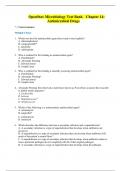
-
OpenStax Microbiology Test Bank Chapter 14: Antimicrobial Drugs
- Exam (elaborations) • 17 pages • 2024
-
- $18.49
- + learn more
OpenStax Microbiology Test Bank Chapter 14: Antimicrobial Drugs * = Correct answer Multiple Choice 1. Which was the first antimicrobial agent discovered to treat syphilis? A. chloramphenicol B. compound 606* C. penicillin D. sulfonamide 2. Who is credited for first finding an antimicrobial agent? A. Paul Ehrlich* B. Alexander Fleming C. Edward Jenner D. Joseph Lister 3. Who is credited for first finding a naturally occurring antimicrobial agent? A. Paul Ehrlich B. Alexa...

-
AMR Exam 1 Questions and Answered 2023
- Exam (elaborations) • 4 pages • 2023
-
- $15.99
- + learn more
AMR Exam 1 Questions and Answered 2023 Side effects of tetracyclines - Photosensitivity - Liver damage - Tooth discoloration Side effects of B-lactams - Allergic reactions, itchy skin & rashes - Liver damage (carbapenems) side effects of quinolones - Photosensitivity - Neurotoxicity Side effects of aminoglycosides - Kidney damage - Hearing loss Side effects of rifampin and isoniazid - Liver damage - Neurotoxicity Side effects of chloramphenicol - S...
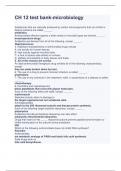
-
CH 12 test bank-microbiology
- Exam (elaborations) • 7 pages • 2023
-
- $12.99
- + learn more
CH 12 test bank-microbiology Substances that are naturally produced by certain microorganisms that can inhibit or destroy bacteria are called ______. antibiotics Antimicrobials effective against a wide variety of microbial types are termed ______. broad-spectrum drugs Antibiotics are derived from all of the following, except ______. Staphylococcus 4. Important characteristics of antimicrobial drugs include A. low toxicity for human tissues. B. high toxicity against microbial cells. C...

-
MSN 571 PHARMACOLOGY MIDTERM EXAM QUESTIONS AND ANSWERS 2022
- Exam (elaborations) • 32 pages • 2022
-
- $11.99
- 1x sold
- + learn more
MSN 571 PHARMACOLOGY MIDTERM EXAM QUESTIONS AND ANSWERS 2022 MID-TERM PHARMACOLOGY QUESTIONS 1. Which of the following is a common cause of iron deficiency in patient? a. Rapid grown during adolescence b. Vegetarian eating pattern c. Decreased intestinal uptake of iron d. Chronic blood lossthrough the gastrointestinal tract. 2. Which of the most common type of anemia? a. Iron deficiency anemia 3. A patient is taking oral ketoconazole for a systemic fungal infection. The medicati...
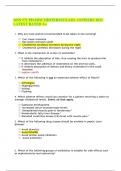
-
MSN 571 PHARM MIDTERM EXAM1 ANSWERS 2023 LATEST RATED A+
- Exam (elaborations) • 13 pages • 2023
-
- $12.99
- + learn more
1. Why are most statins recommended to be taken in the evening? Can cause insomnia Decreases stomach upset Cholesterol synthesis increases during the night Cholesterol synthesis decreases during the night 2. What is the mechanism of action of ezetimibe? It inhibits the absorption of bile, thus causing the liver to produce bile from cholesterol.* It decreases the adhesion of cholesterol on the arterial walls. It inhibits absorption of dietary and biliary chole...
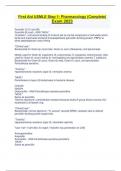
-
First Aid USMLE Step 1- Pharmacology (Complete) Exam 2023
- Exam (elaborations) • 83 pages • 2023
- Available in package deal
-
- $18.49
- + learn more
First Aid USMLE Step 1- Pharmacology (Complete) Exam 2023 Penicillin G (IV and IM) Penicillin M (oral) - ANS-*MOA:* *β-lactam*: a structural analog of D-ala-D-ala (a normal component of cell walls) which binds and inactivates bacterial transpeptidases (penicillin-binding protein, PBPs) to block peptidoglycan cross linking *Clinical use:* Bactericidal for Gram-⊕ cocci/rods, Gram-⊖ cocci (Neisseria), and spirochetes Mostly used for Gram-⊕ organisms (S. pneumoniae, S. pyogenes, A...
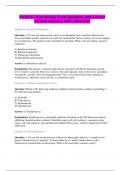
-
USMLE: Microbiology Exam Questions with Correct Verified Solutions 100% 2024/2025
- Exam (elaborations) • 3 pages • 2024
- Available in package deal
-
- $9.99
- + learn more
USMLE: Microbiology Exam Questions with Correct Verified Solutions 100% 2024/2025 Question 1: Bacterial Pathogenesis Question: A 32-year-old man presents with a fever, headache, and a rash that started on his wrists and ankles and has spread to his trunk. On examination, he has a history of recent camping in a wooded area. The patient's rash is described as petechial. What is the most likely causative organism? A) Rickettsia rickettsii B) Borrelia burgdorferi C) Chlamydia trachomatis ...
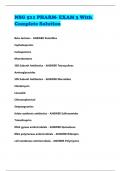
-
NSG 511 PHARM- EXAM 3 With Complete Solution
- Exam (elaborations) • 69 pages • 2024
- Available in package deal
-
- $9.99
- + learn more
NSG 511 PHARM- EXAM 3 With Complete Solution...
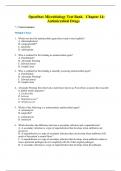
-
OpenStax Microbiology Test Bank Chapter 14: Antimicrobial Drugs
- Exam (elaborations) • 17 pages • 2024
-
Available in package deal
-
- $10.39
- + learn more
OpenStax Microbiology Test Bank Chapter 14: Antimicrobial Drugs * = Correct answer Multiple Choice 1.Which was the first antimicrobial agent discovered to treat syphilis? A.chloramphenicol B.compound 606* C.penicillin D.sulfonamide 2.Who is credited for first finding an antimicrobial agent? A.Paul Ehrlich* B.Alexander Fleming C.Edward Jenner D.Joseph Lister 3.Who is credited for first finding a naturally occurring antimicrobial agent? A.Paul Ehrlich B.Alexander Fleming*...

$6.50 for your textbook summary multiplied by 100 fellow students... Do the math: that's a lot of money! Don't be a thief of your own wallet and start uploading yours now. Discover all about earning on Stuvia


